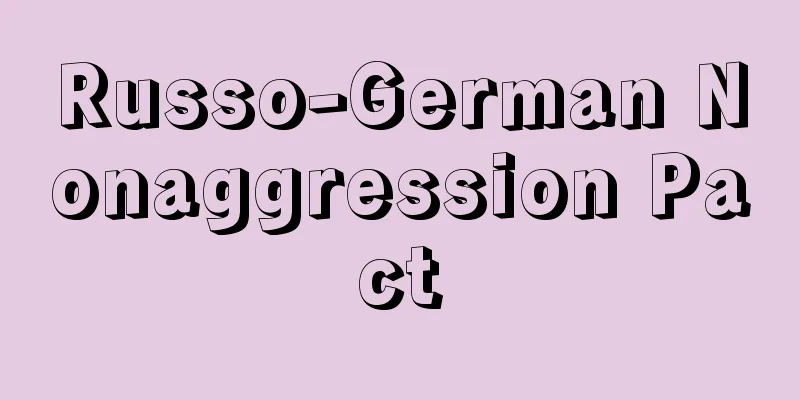Russo-German Nonaggression Pact

|
A treaty between Germany and the Soviet Union signed in Moscow on August 23, 1939, with a secret protocol attached. The treaty had seven articles in total. The two countries promised not to attack each other, not to assist a third country if either of them was attacked by that third country (Article 1), and to consult with each other on issues of common interest (Article 2). It was for a period of 10 years (Article 6) and came into force immediately after signing (Article 7). In the secret protocol, the two countries confirmed that, in the territorial and political reorganization of Eastern Europe, Poland would be divided, with the Narew, Vistula, and San rivers as borders, and that Finland, Estonia, Latvia, and Bessarabia would become Soviet spheres of influence, and Lithuania would become German spheres of influence. However, after the collapse of the Polish state due to the German attack, this point was slightly revised in a secret supplementary protocol to the German-Soviet Boundary and Friendship Treaty signed in Moscow on September 28, 1939, and instead Lithuania was made part of the Soviet sphere of influence, and the dividing line within Poland was determined roughly along the so-called Curzon Line. The conclusion of this treaty surprised the whole world, as no one had expected an alliance between the ideologically incompatible anti-Soviet and anti-Communist Nazi Germany and the anti-fascist socialist Soviet Union. The Japanese Cabinet of Prime Minister Hiranuma Kiichiro, which had been particularly focused on an alliance with Germany, was confronted with this situation and declared it "complicated and bizarre," leading to his en masse resignation. However, Hitler wanted the Soviet Union to remain neutral in order to avoid a two-front war between France and the Soviet Union if the conflict with Poland led to war with Britain and France, while Stalin, distrusting Britain and France and wanting to strengthen his own country's military, wanted to stay outside the sphere of conflict in Europe. In other words, both sides calmly calculated their national interests in realpolitik and suddenly approached each other and concluded the treaty. The establishment of this treaty is thus discussed in connection with the outbreak of World War II, and the Soviet side particularly strongly opposed the secret supplementary protocol published by the United States after the war, and its existence was even questioned at one point. However, today there is no one who dares to deny its existence. [Teruo Yoshida] "Research on the Prehistory of World War II" by Takashi Saito (1965, University of Tokyo Press) "The Origins of World War II" by Taylor, translated by Teruo Yoshida (1977, Chuokoron-Shinsha) [References] | | | |Source: Shogakukan Encyclopedia Nipponica About Encyclopedia Nipponica Information | Legend |
|
1939年8月23日モスクワで調印された独ソ間の条約で、秘密付属議定書が付せられる。条約は全文7か条。両国は相互に攻撃せず、両国の一方が第三国から攻撃された場合、他方はこの第三国を援助しない(第1条)、共通の利害に関する問題では協議する(第2条)などを約し、期間は10年(第6条)、調印と同時に発効する(第7条)という内容であった。両国は、秘密付属議定書において、東欧の領土的・政治的再編成の際、ポーランドを分割し、ナレウ、ビスワ、サンの各河川を境界として、フィンランド、エストニア、ラトビア、ベッサラビアをソ連の、リトアニアをドイツの勢力範囲とすることを確認した。だがこの点は、ドイツの攻撃でポーランド国家が崩壊したのち、39年9月28日モスクワで調印された「独ソ境界・友好条約」の秘密補足議定書では若干修正され、リトアニアはソ連の勢力範囲とされるかわりに、ポーランドの分割線はほぼいわゆるカーゾン線に沿って確定された。 イデオロギー的に相いれない反ソ反共のナチス・ドイツと反ファシズムの社会主義国ソ連との同盟は予想もされなかったから、この条約の成立は全世界を驚倒させた。とくにドイツとの同盟に意を注いでいた日本の平沼騏一郎(きいちろう)内閣は、この事態に直面し、「複雑怪奇である」と声明して総辞職するに至った。だが、ヒトラーは、ポーランドとの紛争が英仏との戦争に至る場合、仏ソの二正面戦争を避けるためソ連の中立を欲したし、他方スターリンは、英仏に対する不信と自国の軍事的強化のため、ヨーロッパでの紛争の圏外にたとうとした。つまり、いずれの側も国家利益を冷静に現実政治的に計算し、にわかに接近して条約を締結したのである。かくてこの条約の成立は第二次世界大戦の勃発(ぼっぱつ)との関連において論じられ、とくに大戦後アメリカ側から発表された秘密付属議定書については、ソ連側は激しく反発し、その存在すら疑われたこともあったが、今日ではその存在をあえて否認するものはみられない。 [吉田輝夫] 『斉藤孝著『第二次世界大戦前史研究』(1965・東京大学出版会)』▽『テイラー著、吉田輝夫訳『第二次世界大戦の起源』(1977・中央公論社)』 [参照項目] | | | |出典 小学館 日本大百科全書(ニッポニカ)日本大百科全書(ニッポニカ)について 情報 | 凡例 |
>>: Collection procedure - Tokusokutetsu continued
Recommend
Hydrochloric acid - Ensan (English spelling)
An aqueous solution of hydrogen chloride (HCl), a...
MOC - MOC
Ministry of Construction . Since 2001, it has been...
Friday - Friday
Same as "Friday." Source: About Shogakuk...
Julia Domna
? ‐217 Wife of the Roman Emperor Septimius Severus...
Hisashi Uzawa
1908-1997 A Noh performer and kotsuzumi player fr...
Shizui Mountain
A prefecture-level city in the northern part of t...
Forlì (English spelling)
Forlì is the capital of the province of Forlì in t...
Arachniodes amabilis (Bl.) Tindale var. fimbriata K. Iwatsuki
An evergreen perennial fern of the Dryopteris fami...
Trikora [mountain] - Trikora
A mountain in the central part of Irian Jaya, Indo...
Mitsutomo Doi
Born: August 29, 1886, Toichi, Kochi [Died] Novemb...
Tomizawa [town] - Tomizawa
A former town in Minamikoma County, in the souther...
Iris (movie) - Iris
...Film critic HA Potamkin pointed out in Theatre...
Chemiosmotic theory
Also known as the Mitchell theory. A theory propos...
Wood, A.
...However, Prava only inserted things into the b...
de Braekeleer, H.
…Even among the Romantics, Wiertz directed his im...









